Tel.:+86-17897571005 E-mail: info@you-fine.com
The Ultimate Guide to Bronze Statue Care and Cleaning
- Home
- The Ultimate Guide to Bronze Statue Care and Cleaning
The Importance of Proper Care and Maintenance of Bronze Sculpture
Proper maintenance and care are crucial for preserving the beauty and longevity of bronze sculptures.
Preservation of Aesthetic Appeal: Regular cleaning and maintenance help prevent the accumulation of dirt, dust, and pollutants that can dull the sculpture’s appearance. By keeping the surface clean and free from debris, the artwork’s original beauty and details can be fully appreciated.
Retention of Patina: The patina, a natural oxidation layer that develops on bronze, adds depth, character, and uniqueness to the sculpture. Proper maintenance techniques, such as gentle cleaning and careful waxing, help preserve the patina’s integrity, enhancing the artwork’s visual appeal and historical value.
Protection against Corrosion and Oxidation: Bronze sculptures are susceptible to corrosion and oxidation due to exposure to the elements. Applying protective coatings, such as wax or specialized products, helps create a barrier that shields the sculpture from environmental factors, preventing damage and ensuring its long-term preservation.
Prevention of Structural Issues: Regular inspections and maintenance allow for the early detection of any structural issues, such as cracks or loose components. Timely repairs and adjustments can prevent further damage and ensure the sculpture’s stability and structural integrity.
Longevity and Value: Well-maintained bronze sculptures have the potential to last for generations, becoming treasured heirlooms or valuable investments. By investing in proper care and maintenance, collectors and owners can ensure the artwork’s longevity and potentially enhance its value over time.
Proper maintenance and care are essential to protect the artistic and monetary value of bronze sculptures, allowing future generations to enjoy their beauty and significance.
Table of Contents
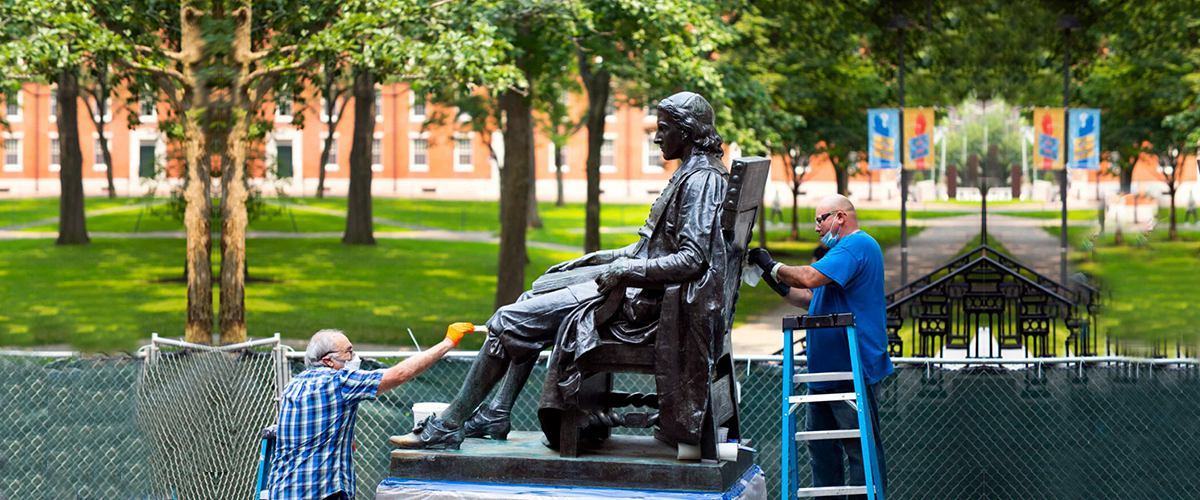
Life-size to Medium-sized Sculptures Simple and Effective Cleaning Methods
Soft, lint-free clothes or brushes
Mild dish soap or specialized bronze cleaner
Distilled water (avoid tap water to prevent mineral deposits)
Gloves (optional) to protect the sculpture from fingerprints
Dusting
Start by gently dusting the sculpture with a soft cloth or brush to remove loose debris. Use a soft brush with natural bristles or compressed air for intricate details and hard-to-reach areas.
Gentle Cleaning
Prepare a mixture of warm water and mild dish soap or a specialized bronze cleaner. Dampen a soft cloth in the solution and gently wipe the surface of the sculpture. Avoid excessive scrubbing or abrasive materials that may damage the patina.
Removing Stubborn Stains
For stubborn stains or grime, dampen a soft cloth with the cleaning solution and let it sit on the affected area for a few minutes. Gently rub the stained area in a circular motion, applying light pressure until the stain loosens. Rinse the cloth frequently and continue until the stain is removed.
Rinse and Dry
After cleaning, rinse the sculpture with distilled water to remove any soap residue. Use a clean, dry cloth to pat the sculpture dry, ensuring there is no moisture left on the surface. Allow the sculpture to air dry completely before applying any protective coatings.
General Maintenance
Regularly inspect the sculpture for any signs of damage, such as cracks, chips, or loose parts. Avoid placing the sculpture in direct sunlight or extreme temperature fluctuations. Apply a thin layer of wax or specialized bronze polish periodically to protect the patina and enhance its longevity.
Tips for Choosing Suitable Cleaning Agents and Tools
Research and consult: Before selecting a cleaning agent, research the sculpture’s material and finish. Consult with the artist or manufacturer for recommended cleaning products to ensure compatibility.
Mild cleaning agents: Opt for mild dish soap or specialized bronze cleaners specifically designed for bronze sculptures. Avoid harsh chemicals, abrasive cleaners, or household products that may damage the sculpture’s surface.
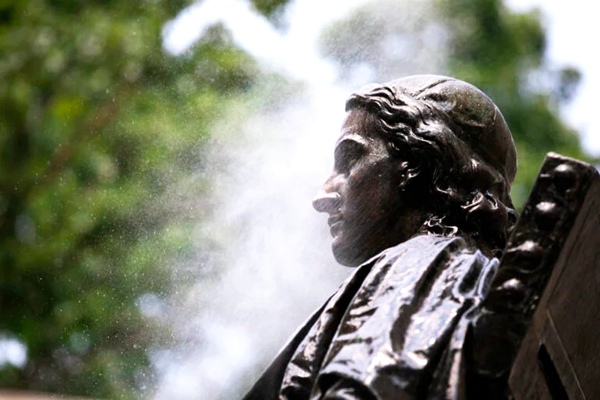
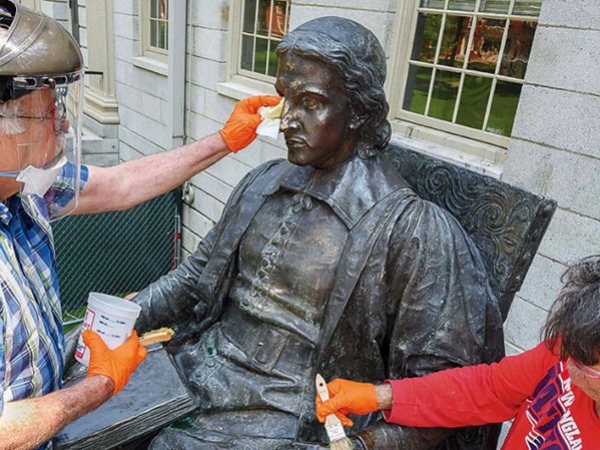
Distilled water: When preparing a cleaning solution, use distilled water instead of tap water to prevent mineral deposits that may affect the sculpture’s appearance.
Soft brushes and cloths: Use soft, lint-free cloths or brushes with natural bristles for gentle cleaning. Avoid rough materials that could scratch or mar the sculpture’s surface.
Basic Cleaning Techniques Step-by-Step
Dusting: Start by using a soft brush or cloth to gently remove loose dust and debris from the sculpture’s surface.
Dilute cleaning solution: Prepare a mixture of warm water and the recommended cleaning agent, following the product instructions for appropriate dilution ratios.
Test a small area: Before applying the cleaning solution to the entire sculpture, test it on a small, inconspicuous area to ensure compatibility and assess any potential adverse reactions.
Dampen the cloth or brush: Moisten a soft cloth or brush with the cleaning solution. Avoid saturating the material excessively to prevent excessive moisture on the sculpture.
Gentle wiping: Gently wipe the sculpture’s surface using light pressure and circular motions. Pay extra attention to intricate details and hard-to-reach areas.
Stubborn stains: For stubborn stains, allow the cleaning solution to sit on the affected area for a few minutes. Then, gently scrub the area with a soft brush or cloth until the stain loosens.
Rinse and dry: After cleaning, rinse the sculpture with distilled water to remove any residue from the cleaning agent. Use a clean, dry cloth to pat the sculpture dry, ensuring no moisture remains.
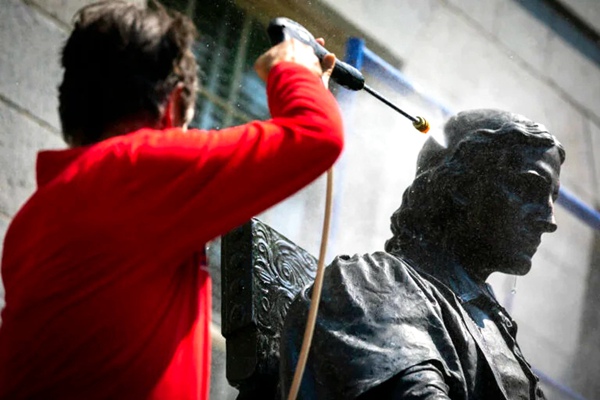
Addressing Common Issues and Providing Solutions
Bird droppings: If your bronze sculpture has bird droppings, it’s crucial to act promptly. Start by wearing protective gloves and gently remove the droppings with a soft cloth or sponge soaked in warm, soapy water. Rinse the affected area with distilled water and pat it dry. For stubborn residue, you can use a mixture of baking soda and water or a specialized bronze cleaner. Apply the solution, let it sit for a few minutes, and then gently scrub the area with a soft brush or cloth.
Paint marks: If your sculpture has paint marks, it’s important to be cautious to avoid damaging the bronze surface. Start by testing a small area with a mild solvent, such as mineral spirits or acetone, using a soft cloth. Gently rub the paint mark until it loosens. If the paint persists, consult with a professional art conservator who can provide expert advice on the appropriate solvents and techniques for safe paint removal.
Rust stains: Rust stains can occur when the bronze surface comes into contact with moisture or metal objects. To remove rust stains, you can use a commercial rust remover specifically designed for use on bronze. Follow the product instructions carefully, as some rust removers may require multiple applications or specific time frames for optimal results. After treating the rust, rinse the area thoroughly and dry it to prevent further oxidation.
Mineral deposits: Hard water or mineral-rich environments can lead to the buildup of mineral deposits on bronze surfaces. To remove these deposits, create a mixture of equal parts white vinegar and water. Apply the solution to the affected area and gently scrub with a soft brush or cloth. Rinse with distilled water and pat dry. Avoid using abrasive materials or harsh chemicals that may damage the bronze.
Environmental pollutants: Outdoor bronze sculptures may accumulate pollutants such as soot, smog, or atmospheric residues over time. To clean these pollutants, start by gently rinsing the sculpture with distilled water to remove loose debris. Then, apply a mild detergent solution to the surface and gently scrub with a soft brush or cloth. Rinse thoroughly with distilled water and pat dry. It’s important to avoid abrasive cleaning agents or techniques that may cause scratches or damage.
Organic growth: In humid or moist environments, bronze sculptures may develop organic growth, such as algae or moss. To address this issue, start by removing the growth manually using a soft brush or cloth. Then, apply a mixture of water and mild detergent or a specialized biocide solution to the affected area. Let it sit for a recommended period, as per the product instructions, and then rinse thoroughly with distilled water. Repeat the process if necessary, and ensure the sculpture is completely dry after cleaning.
Other stubborn stains: For stubborn stains or contaminants like adhesive residue, tar, or grease, it’s best to seek professional assistance from an art conservator or restoration expert. They have the knowledge and expertise to handle complex cleaning challenges without causing harm to the sculpture’s surface.
Faced with Challenging Cleaning Situations
When faced with challenging cleaning situations on bronze sculptures, advanced cleaning techniques can be employed to ensure safe and effective removal while minimizing any potential impact on the sculpture’s surface. Here are some advanced cleaning methods along with detailed guidance on their safe and effective application:
Laser cleaning: Laser technology can be used to remove tough stains or coatings from bronze surfaces. This non-contact cleaning method involves using a laser beam to target and vaporize the unwanted material without damaging the underlying bronze. Laser cleaning should only be performed by trained professionals who have experience with this technique to ensure precise control and minimize the risk of unintended damage.
Micro-abrasion: Micro-abrasion involves using fine abrasive particles in a controlled manner to gently remove stubborn stains or contaminants from the bronze surface. This method is particularly useful for intricate or delicate sculptures. A professional restorer should perform micro-abrasion, as they possess the expertise to select the appropriate abrasives and techniques that will effectively clean the surface without causing harm.
Chemical poultices: For specific stains or discolorations that are difficult to remove, chemical poultices can be applied to the affected area. A poultice consists of a mixture of a suitable cleaning agent and an absorbent material, such as kaolin clay or diatomaceous earth. The poultice is applied to the stain, covered with a protective layer, and left to work for a specified period. It helps draw out the stain or discoloration from the bronze surface. Following the manufacturer’s instructions and exercising caution are crucial when using chemical poultices to avoid any adverse effects on the sculpture.
Protect the Natural Patina
When cleaning bronze sculptures, it is important to protect the natural patina, including the characteristic green patina known as “verdigris.” Here are some techniques to safeguard the patina during the cleaning process
Avoid abrasive materials: Use soft, non-abrasive materials such as microfiber cloths, soft brushes, or cotton swabs to gently clean the surface. Avoid using abrasive scrubbers or rough materials that could potentially damage the patina.
Test cleaning solutions: Before applying any cleaning solution to the sculpture, conduct a patch test on a small, inconspicuous area to ensure that it does not harm or alter the patina. Choose a cleaning solution that is specifically formulated for bronze or metal surfaces and follow the manufacturer’s instructions.
Gentle cleaning motions: When cleaning the bronze surface, use gentle and circular motions to avoid applying excessive pressure or causing friction that may disturb or remove the patina.
Rinse thoroughly: After cleaning, rinse the sculpture thoroughly with clean water to remove any residue from the cleaning solution. Ensure that no cleaning solution is left on the surface, as it could potentially affect the patina over time.
Apply protective coatings: If desired, a thin layer of protective wax or clear lacquer can be applied to the bronze surface to help preserve and protect the patina. Consult with a professional conservator to determine the most suitable protective coating for your sculpture.
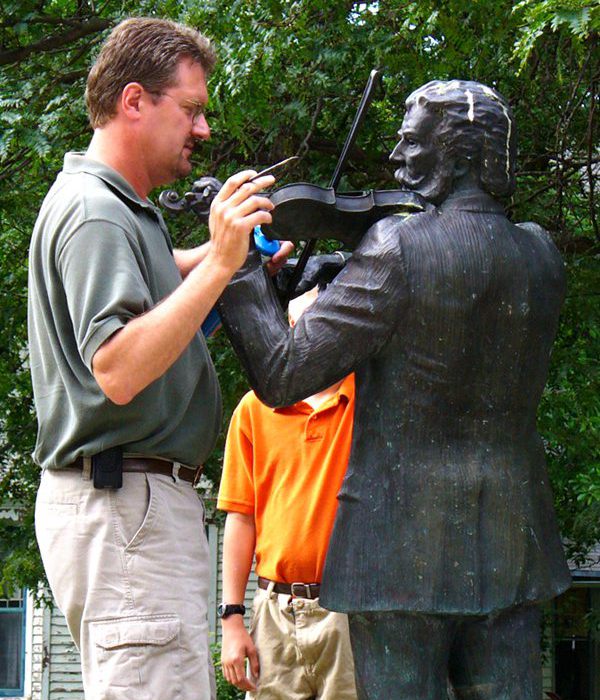
Large-scale Bronze Sculptures Maintaining and Preserving Suggestion
Maintaining and preserving large-scale bronze sculptures presents unique challenges due to their size and exposure to various environmental factors. Here are some key challenges to consider
Weathering and corrosion: Large sculptures are often exposed to harsh weather conditions, including rain, UV radiation, and extreme temperatures. Over time, these elements can cause weathering, corrosion, and damage to the bronze surface.
Structural integrity: The size and weight of large sculptures can pose structural challenges. Regular inspections are necessary to ensure the stability and structural integrity of the sculpture, including checking for any signs of cracks, loose components, or potential safety hazards.
Cleaning and maintenance access: Due to their size and complexity, cleaning and maintaining large sculptures may require specialized equipment and expertise. Accessing all areas of the sculpture for cleaning and maintenance purposes can be challenging, especially for intricate or elevated sections.
Conservation and restoration: Large sculptures may require periodic conservation and restoration interventions to address issues such as corrosion, surface damage, or aging. These processes often involve specialized techniques and the expertise of professional conservators.
Site-specific considerations: Large sculptures installed in public spaces or outdoor environments may face additional challenges related to vandalism, pollution, graffiti, or accidental damage. Developing appropriate security measures and implementing preventive maintenance strategies is crucial to ensure the longevity of the sculpture.
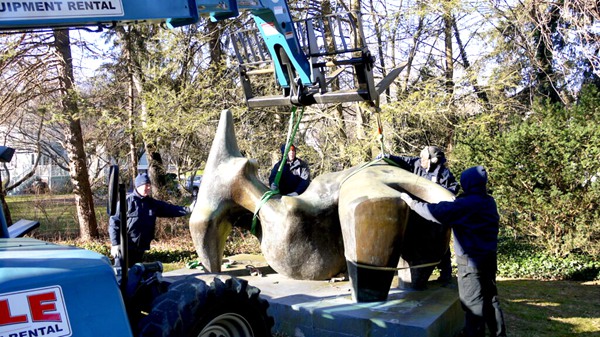
Professional Assistance Guide
Professional Assistance Guide for Handling and Cleaning Large Bronze Sculptures
Maintaining and cleaning large bronze sculptures requires professional expertise to ensure proper care and preservation. Here is a guide to seeking professional assistance
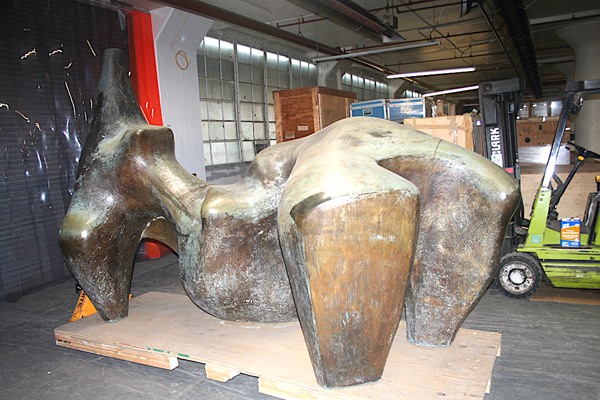
Conservation experts: Consult with professional conservators who specialize in bronze sculpture conservation. They have the knowledge and skills to assess the condition of the sculpture, identify any potential issues, and recommend appropriate preservation and cleaning methods.
Structural engineers: Engage structural engineers to evaluate the stability and safety of the sculpture. They can conduct inspections, perform load analyses, and provide recommendations for reinforcing or repairing any structural weaknesses.
Cleaning specialists: Seek the services of cleaning specialists experienced in working with large sculptures. They can develop customized cleaning plans and utilize techniques and equipment suitable for the sculpture’s size and intricacy. These specialists will have the expertise to safely remove dirt, grime, and pollutants without causing harm to the sculpture’s surface.
Restoration professionals: If the sculpture requires restoration due to damage or deterioration, hire experienced restoration professionals. They can meticulously repair and restore the sculpture using appropriate materials and techniques, ensuring its historical and artistic integrity is preserved.
Art logistics experts: For transportation, installation, and relocation of large sculptures, engage art logistics specialists. They possess the necessary equipment and expertise to safely handle, transport, and install the sculpture, minimizing the risk of damage during the process.
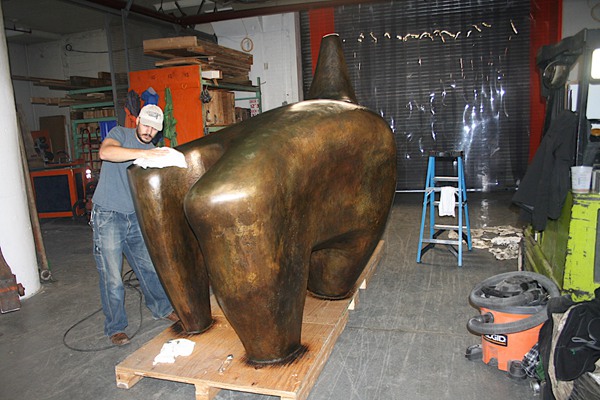
Recommendations for Choosing Qualified Experts
Recommendations for Choosing Qualified Experts for Restoration and Preservation
When it comes to restoration and preservation of bronze sculptures, selecting qualified experts is crucial. Here are some suggestions to help you choose the right professionals
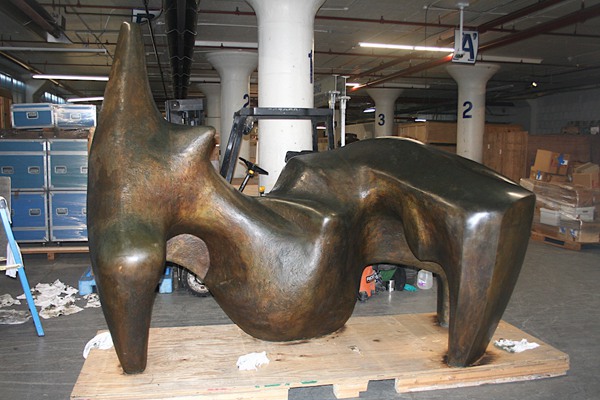
Research and credentials: Conduct thorough research on restoration experts and conservators specializing in bronze sculpture. Look for their qualifications, certifications, and memberships in professional organizations related to art conservation.
Experience and expertise: Consider the professionals’ experience in working with bronze sculptures and their track record of successful restoration projects. Look for expertise in handling specific styles or artists’ works that align with your sculpture.
Portfolio and references: Review their portfolio of past restoration projects to assess the quality of their work. Request references and reach out to previous clients to inquire about their experience, satisfaction, and the longevity of the restored sculptures.
Consultation and assessment: Schedule consultations with potential experts to discuss your sculpture’s restoration and preservation needs. During these meetings, ask about their assessment process, proposed treatment plans, and estimated timelines and costs.
Collaboration and recommendations: Seek professionals who are open to collaboration and willing to involve you in the decision-making process. They should provide recommendations on preventive measures, maintenance routines, and display conditions to ensure the long-term preservation of your sculpture.
Transparency and documentation: Choose experts who maintain transparent communication throughout the restoration process. They should provide detailed documentation, including condition reports, treatment proposals, and photographic records, to ensure transparency and accountability.
Conservation ethics: Ensure that the chosen experts adhere to ethical standards and practices in art conservation. They should prioritize preserving the historical and artistic integrity of the sculpture while using reversible treatments and materials.
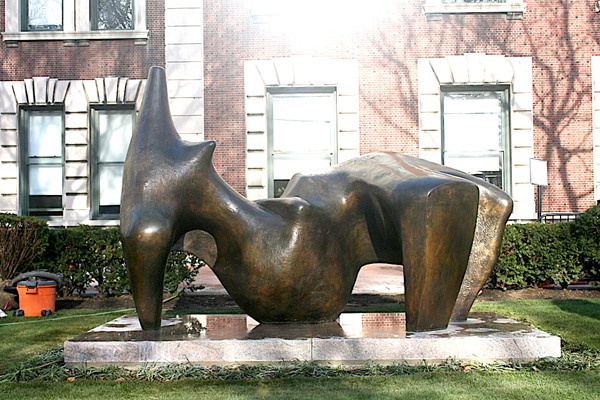
Contact YouFine
Contact Info
- +86-17897571005
- sales@you-fine.com
Fill out the form below and we will
contact you as soon as possible!
How to Protect Bronze Sculptures from Environmental Factors
Importance of Protective Measures and Maintenance
Protecting bronze sculptures from environmental factors is essential to ensure their longevity and preserve their aesthetic appeal. Here are the reasons why protective measures and maintenance are crucial
Preventing corrosion: Bronze sculptures are susceptible to corrosion due to exposure to moisture, air pollutants, and harsh weather conditions. Implementing protective measures such as coatings, sealants, and periodic cleaning helps create a barrier against these corrosive elements.
Retaining surface integrity: Environmental factors like UV radiation, temperature fluctuations, and atmospheric pollutants can degrade the surface of bronze sculptures over time. Regular maintenance, including cleaning, waxing, and applying protective coatings, helps preserve the sculpture’s surface integrity and prevents discoloration or deterioration.
Avoiding physical damage: External factors like vandalism, accidental impact, or natural disasters can pose a risk to bronze sculptures. Implementing protective measures such as appropriate placement, secure anchoring, and installing security systems or barriers helps minimize the chances of physical damage and vandalism.
Preserving aesthetic value: Bronze sculptures are renowned for their visual appeal and artistic value. Protecting them from environmental factors ensures that their original beauty, patina, and intricate details are preserved, allowing viewers to appreciate and enjoy them as intended by the artist.
Long-term investment: Bronze sculptures often hold significant financial and sentimental value. By implementing protective measures and regular maintenance, you are safeguarding your investment and ensuring that the sculpture retains its value over time.
Cultural heritage preservation: Many bronze sculptures hold historical, cultural, and artistic significance. Proper protection and maintenance contribute to the preservation of our cultural heritage, allowing future generations to appreciate and learn from these masterpieces.
Professional expertise: Seeking guidance from professionals in the field of sculpture conservation can provide valuable insights and customized recommendations for protecting your bronze sculpture based on its unique characteristics and environmental conditions.
The Importance of Protecting Sculptures from Weather Effects
Weather conditions can significantly impact the condition and longevity of sculptures, making it crucial to prioritize their protection. Here are the reasons why safeguarding sculptures from weather effects is important
Preventing water damage: Moisture accumulation or prolonged exposure to rainwater can result in corrosion, mold growth, or deterioration of sculptures. Regular inspection, drainage systems, and ensuring proper sealing or waterproofing can help prevent water-related damage.
Ensuring long-term aesthetics: Weather-related damage can significantly impact the aesthetic appeal of sculptures, altering their color, texture, or surface finish. By protecting sculptures from weather effects, you can maintain their original beauty and ensure they continue to be visually captivating.
Extending lifespan and value: Proper protection from weather effects helps extend the lifespan of sculptures and maintain their value. By preserving their condition and aesthetics, sculptures can retain their financial and cultural significance for future generations.
Preventing erosion: Exposure to harsh weather elements like rain, snow, and wind can lead to erosion of the sculpture’s surface over time. Protective measures such as applying sealants or coatings help create a barrier against moisture and prevent erosion, preserving the sculpture’s integrity.
Minimizing temperature-related damage: Extreme temperatures, including freezing and high heat, can cause expansion and contraction of the sculpture’s materials, leading to cracks or structural damage. Protecting sculptures from temperature fluctuations through appropriate placement or the use of shading devices helps minimize these risks.
Reducing UV damage: Prolonged exposure to sunlight and UV radiation can cause fading, discoloration, and degradation of materials used in sculptures. Implementing protective measures like UV-resistant coatings or positioning sculptures in shaded areas helps minimize the damaging effects of UV rays.
Strategies for Wind and Weather Protection and Corrosion Prevention
Protecting sculptures from wind, rain, and corrosion is crucial for their long-term preservation. Here are some effective strategies to safeguard sculptures from these elements
Wind protection: Large and freestanding sculptures are vulnerable to strong winds, which can cause instability or even topple them. Anchoring the sculpture securely to a stable base or foundation helps prevent wind-related damage. Additionally, strategic placement in sheltered areas or behind windbreaks, such as trees or structures, can provide additional protection.
Rainwater management: Proper drainage is essential to prevent water from accumulating on or around the sculpture. This can be achieved through the use of gutters, downspouts, or carefully designed landscaping features that direct water away from the sculpture. Regular inspection and maintenance of drainage systems are important to ensure their effectiveness.
Corrosion prevention: Bronze sculptures are susceptible to corrosion over time, especially when exposed to moisture and atmospheric pollutants. Applying protective coatings or sealants specifically designed for bronze can create a barrier against corrosion. Regular cleaning to remove dirt, pollutants, and bird droppings also helps prevent corrosion.
Protective barriers: Installing physical barriers, such as fences or enclosures, around sculptures can provide an additional layer of protection against vandalism, accidental damage, or exposure to harsh weather conditions. The barriers should be aesthetically pleasing and designed to complement the sculpture without obstructing its view.
Maintenance and inspections: Regular inspections and maintenance are crucial for identifying any signs of damage, corrosion, or deterioration early on. Prompt repairs and necessary touch-ups should be conducted to prevent further deterioration and ensure the sculpture’s long-term preservation.
Material selection: When commissioning or acquiring sculptures, choosing materials that are resistant to corrosion and weathering, such as high-quality bronze, stainless steel, or weather-resistant alloys, can significantly reduce the risk of damage and prolong the sculpture’s lifespan.
Emphasizing the Importance of Applying Protective Coatings
Applying protective coatings, such as wax, to bronze sculptures is of utmost importance to shield them from environmental factors. These coatings create a barrier that safeguards the sculptures from moisture, pollutants, and oxidation. It is recommended to use coatings specifically designed for long-term preservation. Here are some recommended coatings and sealants
Microcrystalline Wax: Widely regarded as an effective protective coating, microcrystalline wax provides excellent resistance to moisture, pollutants, and UV radiation. It forms a durable and transparent layer that preserves the sculpture’s appearance while inhibiting corrosion and oxidation.
Clear Acrylic Coatings: Clear acrylic coatings offer good protection against environmental elements, including moisture, dirt, and UV radiation. They provide a transparent and flexible layer that enhances the sculpture’s visual appeal and prolongs its lifespan.
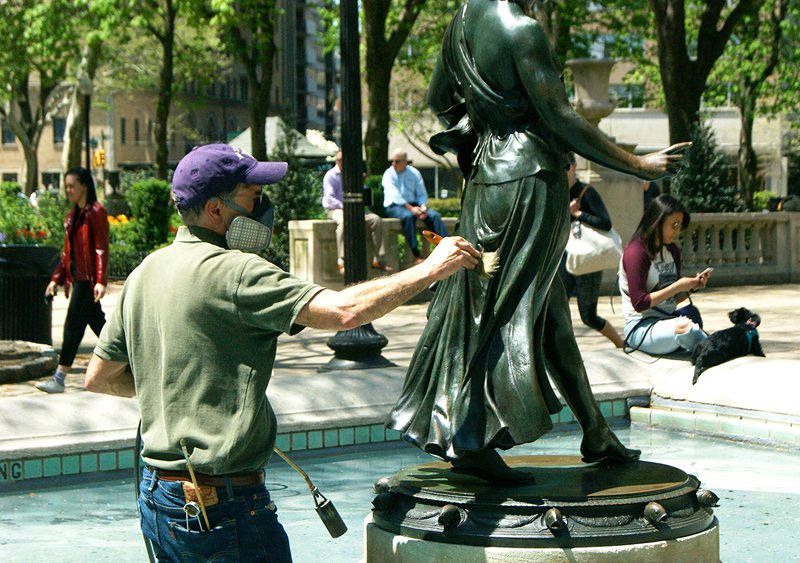
Polyurethane Sealants: Polyurethane sealants are known for their exceptional durability and weather resistance. They form a protective film that guards against moisture, chemicals, and harsh weather conditions. These sealants are especially useful for sculptures exposed to high levels of humidity or located in coastal areas.
Silicone Coatings: Silicone coatings provide a waterproof barrier that shields sculptures from rain, moisture, and oxidation. They offer excellent UV resistance and durability, making them suitable for sculptures exposed to intense sunlight and harsh environmental conditions.
When applying protective coatings, it is important to follow the manufacturer’s instructions and ensure that the sculpture’s surface is clean and dry. Regular maintenance, including the reapplication of coatings, as needed, will help maintain the protective barrier and preserve the sculpture’s integrity over time.
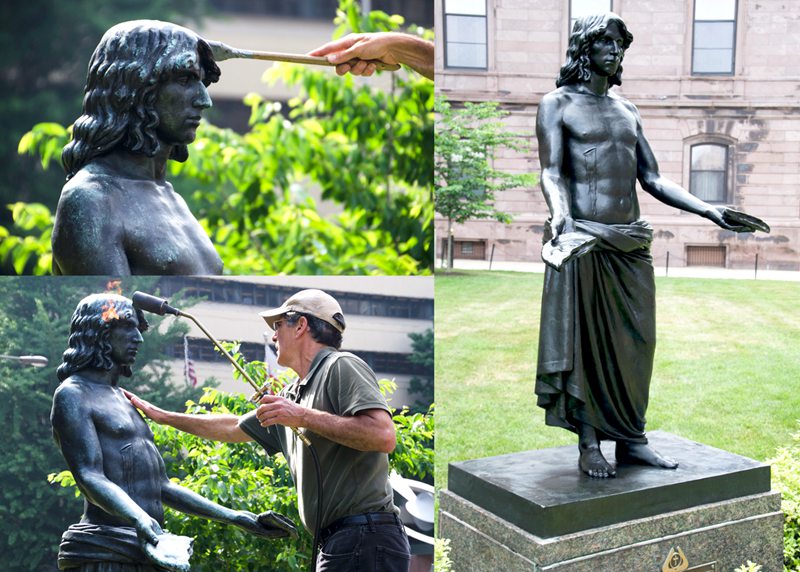
How to Proper Installation and Maintenance Bronze Sculptures
Displaying and storing bronze sculptures requires careful attention to ensure their safety and optimal presentation. Here are some guidelines for the correct positioning and installation
Stability and Balance: Ensure that the sculpture is positioned on a stable and level surface. Use pedestals or bases that are appropriate for the size and weight of the sculpture to maintain stability and balance.
Adequate Support: Larger sculptures may require additional support to prevent tipping or leaning. Consult with a professional installer or art handler to determine the appropriate support system, such as concealed brackets or steel armatures, to securely hold the sculpture in place.
Weight Distribution: Distribute the weight of the sculpture evenly on the support surface to prevent undue stress on specific areas. Use padding or felt material between the sculpture and the base to prevent scratching or damage.
Environmental Considerations: Place the sculpture away from direct sunlight, extreme temperature fluctuations, and high humidity levels. Exposure to these factors can accelerate deterioration and cause discoloration or warping of the bronze surface.
Lighting: Illuminate the sculpture appropriately to enhance its visual impact. Use well-placed spotlights or gallery lighting to highlight the sculpture’s features and create a captivating display. Avoid using harsh or direct lighting that can cause glare or heat damage.
Security Measures: If displaying sculptures in public areas or outdoor spaces, consider implementing security measures to deter theft or vandalism. Install surveillance cameras, alarms, or physical barriers to protect the artwork.
Cleaning and Maintenance: Regularly clean and inspect the sculpture to remove dust, dirt, and debris. Use soft brushes or lint-free cloths to gently wipe the surface. Avoid using abrasive materials or harsh chemicals that can damage the patina or finish. Consult with a professional conservator for specialized cleaning and maintenance needs.
By following these guidelines for positioning and installing bronze sculptures, you can ensure their stability, protection, and optimal presentation, whether in galleries, public spaces, or private collections. Proper care and attention to display and storage considerations will contribute to the longevity and preservation of these artistic treasures.
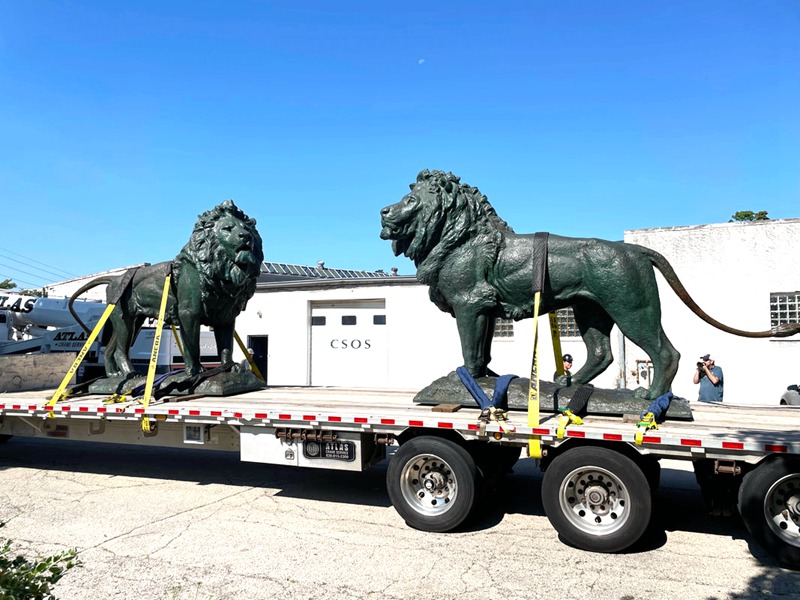
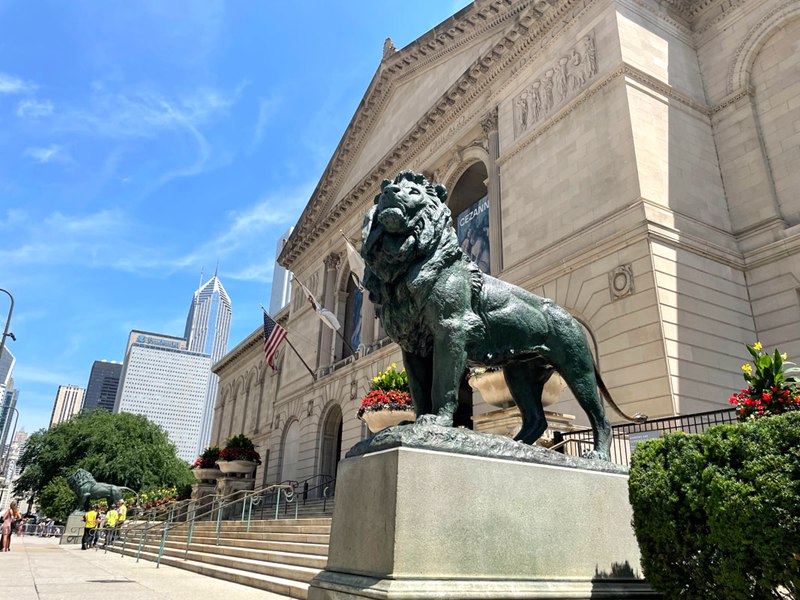
Indoor and Outdoor Display Options
When considering the display of bronze sculptures, it’s important to take into account whether they will be showcased indoors or outdoors. Here are some tips for each scenario. Whether displayed indoors or outdoors, proper consideration of the environment, lighting, security, and integration with the surroundings will enhance the overall impact and longevity of the bronze sculptures.
Indoor Display:
Gallery or Exhibition Space: Consider exhibiting the sculptures in dedicated gallery or exhibition spaces where lighting, temperature, and humidity levels can be controlled and monitored.
Pedestals or Display Cases: Use pedestals or display cases to elevate and protect the sculptures. These provide a focal point and help create a visually appealing presentation.
Lighting: Install appropriate lighting fixtures to highlight the sculptures’ details and create an immersive viewing experience. Use a combination of ambient and directed lighting to achieve the desired effect.
Background and Surroundings: Choose a suitable backdrop or wall color that complements the sculptures and enhances their visual impact. Consider the overall aesthetics and ensure that the sculptures stand out as focal points.
Outdoor Display:
Weather Resistance: Select bronze sculptures that are specifically designed for outdoor display and can withstand exposure to weather elements. Look for sculptures with protective coatings or patinas that can resist fading and corrosion.
Landscape Integration: Integrate the sculptures into the outdoor environment, considering factors such as scale, surroundings, and landscaping. Choose locations that offer visual interest and provide a harmonious connection between the sculptures and nature.
Mounting and Anchoring: Use secure and durable mounting methods to anchor the sculptures in outdoor settings. This will prevent theft or accidental displacement due to weather conditions or human interference.
Lighting and Security: Install outdoor lighting to showcase the sculptures during nighttime and ensure their visibility. Implement security measures such as surveillance cameras or alarms to protect the artwork from theft or vandalism.
Safety Storage Guidelines during Transportation or Renovation
Transporting or renovating bronze sculptures requires careful planning and execution to ensure their safety and preservation. Here are some guidelines for secure storage during these processes
Packing and Crating: Use appropriate packing materials, such as foam, bubble wrap, or custom-fit crates, to protect the sculptures from physical damage. Ensure that the packing is secure and provides sufficient cushioning to absorb shocks during transportation.
Climate Control: If possible, maintain a controlled environment during transportation or storage to minimize temperature and humidity fluctuations. Extreme temperature or humidity changes can cause expansion, contraction, or condensation, leading to potential damage.
Handling and Lifting: Employ trained professionals who have experience in handling delicate and heavy artwork. Use specialized equipment, such as cranes or forklifts, to lift and move the sculptures safely, ensuring proper weight distribution and support.
Secure Storage Facility: Store the sculptures in a secure facility that offers protection against theft, vandalism, and environmental hazards. The facility should have appropriate security measures, including surveillance systems, alarms, and restricted access.
Documentation and Inventory: Maintain detailed documentation and an inventory of the sculptures throughout the transportation or renovation process. This includes photographs, condition reports, and records of any changes or repairs made.
Restoration and Conservation: If renovations or repairs are required, consult professional conservators or restorers who specialize in bronze sculptures. Ensure that the selected experts have the necessary expertise and follow ethical guidelines for conservation practices.
Regular Inspection: Periodically inspect the stored sculptures to check for any signs of damage, such as cracks, corrosion, or pest infestation. Promptly address any issues to prevent further deterioration.
Benefits of Regular Maintenance
Regular maintenance is crucial for the care and longevity of bronze sculptures. Here are the benefits of conducting routine inspections, performing repairs, and addressing potential structural issues
Preservation: Regular maintenance helps preserve the integrity and aesthetic appeal of the sculptures. By identifying and addressing issues early on, you can prevent further damage and deterioration, ensuring the sculptures remain in optimal condition.
Structural Stability: Inspections allow you to assess the structural stability of the sculptures. Identifying any potential weaknesses or structural issues early on enables you to take appropriate measures to reinforce or repair them, ensuring the sculptures’ stability and preventing accidents or damage.
Damage Prevention: Routine inspections help identify and address factors that may cause damage, such as corrosion, environmental factors, or wear and tear. By proactively addressing these issues, you can mitigate potential damage and extend the lifespan of the sculptures.
Conservation: Regular maintenance aligns with the principles of conservation, aiming to preserve the original intent and integrity of the artworks. By addressing any deterioration or damage promptly, you can prevent irreversible changes and ensure the sculptures retain their artistic and historical value.
Cost Savings: Timely maintenance can prevent minor issues from escalating into major problems that require extensive and costly repairs. By addressing maintenance needs promptly, you can save on repair expenses in the long run and avoid potential restoration expenses.
Expert Assessment: Regular inspections provide an opportunity for professional assessment and guidance. Engaging experts who specialize in bronze sculpture conservation can help identify potential issues and recommend appropriate maintenance measures, ensuring the sculptures receive the necessary care and attention.
Peace of Mind: Knowing that your bronze sculptures are regularly inspected, maintained, and addressed for potential issues gives you peace of mind. It allows you to enjoy and appreciate the sculptures without worrying about their condition or the risk of significant damage.
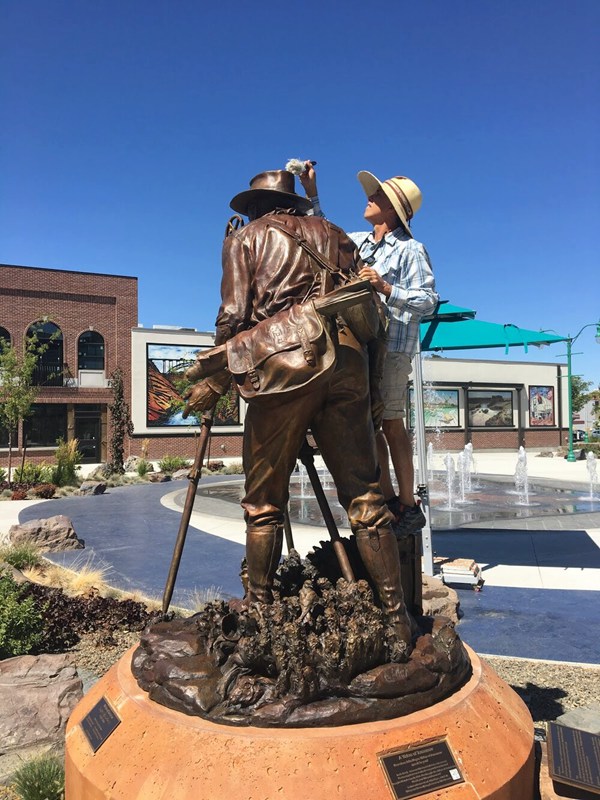
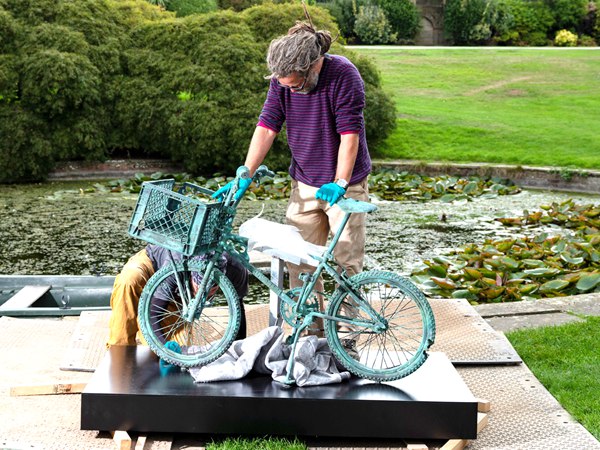
Essential Tools and Supplies for Bronze Sculpture Care Guide
Proper care of bronze sculptures requires the use of specific tools, brushes, and cleaning agents. Here is an overview of the essential items needed for effective bronze sculpture care
Soft Bristle Brushes: Use soft-bristled brushes, such as natural fiber brushes or soft artist brushes, for gentle cleaning and dusting of the sculptures. Avoid using abrasive or harsh brushes that could scratch or damage the surface.
Microfiber Cloths: Microfiber cloths are ideal for gently wiping and removing dust from the sculptures. They are soft and non-abrasive, minimizing the risk of scratching the bronze surface.
Mild Soap or Detergent: Choose a mild soap or detergent specifically formulated for delicate surfaces. Dilute it with water and use it sparingly for general cleaning purposes. Avoid using harsh chemicals or abrasive cleaners that can corrode or discolor the bronze.
Distilled Water: Distilled water is recommended for cleaning bronze sculptures, as it is free from impurities that can potentially cause damage. Avoid using tap water, which may contain minerals or chemicals that could react with the bronze.
Soft Toothbrush: A soft-bristled toothbrush can be useful for cleaning hard-to-reach areas or intricate details of the sculptures. Use it gently to remove dust or debris without applying excessive pressure.
Protective Gloves: Wear protective gloves, such as cotton or latex gloves, when handling bronze sculptures during cleaning. This helps prevent the transfer of oils, dirt, or chemicals from your hands to the sculpture’s surface.
Wax or Protective Coating: Applying a thin layer of wax or protective coating can help preserve the luster and protect the bronze from environmental factors. Choose a wax or coating specifically formulated for bronze sculptures and follow the manufacturer’s instructions for application.
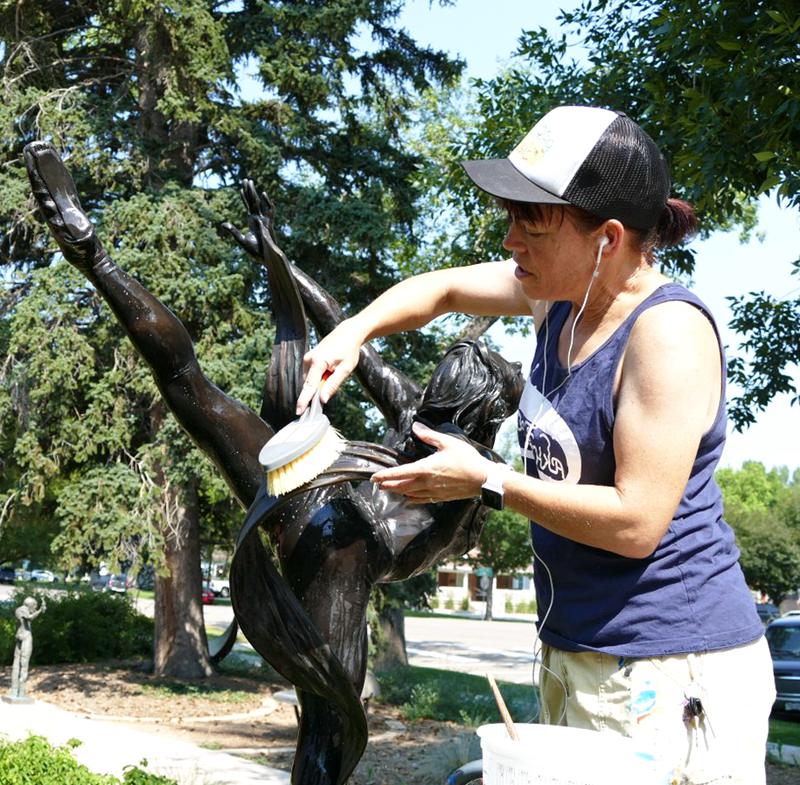
What are the Safe and Effective Cleaning Products
When it comes to selecting safe and effective cleaning products for bronze sculptures, it is crucial to choose those specifically designed for delicate surfaces. Here are some recommended cleaning products
pH-Neutral Cleaners: Look for pH-neutral cleaners that are formulated to be gentle and non-reactive with bronze. These cleaners are less likely to cause any damage or discoloration to the sculpture’s surface.
Commercial Bronze Cleaners: There are various commercial bronze cleaners available in the market that are specifically designed for cleaning and maintaining bronze sculptures. These cleaners often contain mild detergents and ingredients that help remove dirt, grime, and oxidation without harming the metal.
Natural Cleaners: For those who prefer more natural options, there are eco-friendly cleaners available that are safe for bronze. Some examples include vinegar diluted with water, lemon juice, or baking soda mixed with water to form a paste. These natural cleaners can be effective in removing light dirt and stains.
Microcrystalline Wax: Microcrystalline wax is commonly used to protect and preserve bronze sculptures. It creates a thin protective layer that helps prevent oxidation and environmental damage. Ensure you choose a high-quality microcrystalline wax specifically formulated for use on bronze.
It is important to carefully read the instructions provided by the manufacturers and test any new cleaning product on a small, inconspicuous area of the sculpture before applying it to the entire surface. This will help ensure compatibility and prevent any potential adverse reactions.
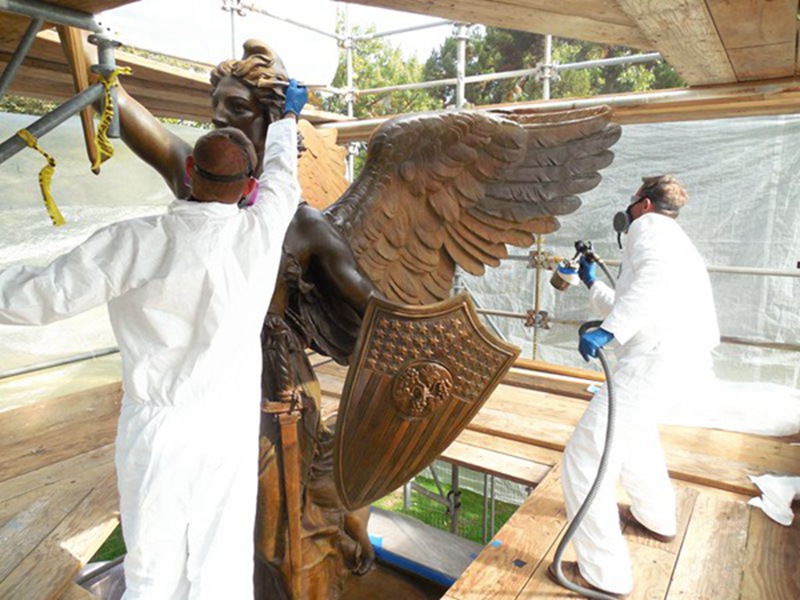
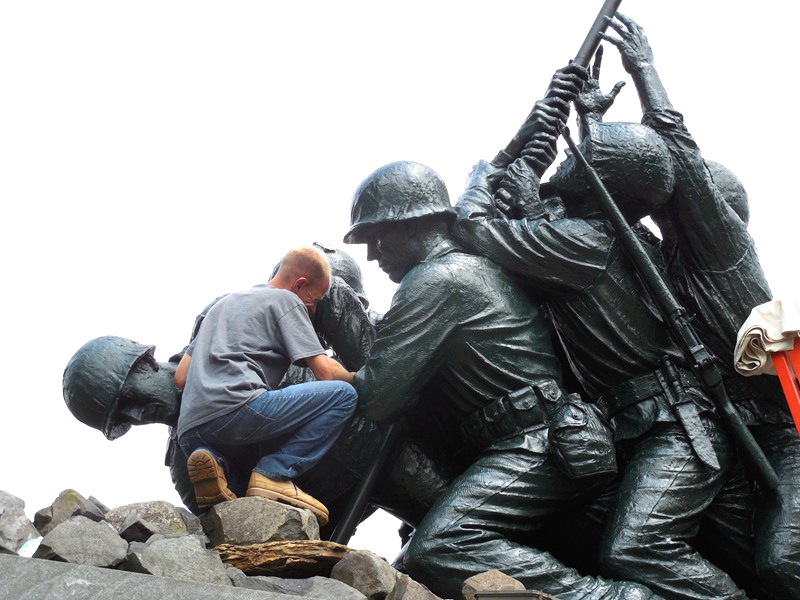
Where to Get Professional Cleaning Equipment
When it comes to obtaining professional cleaning equipment for bronze sculptures, there are several resources available
Art Supply Stores: Many art supply stores carry a range of specialized cleaning tools and equipment suitable for maintaining bronze sculptures. These stores often have knowledgeable staff who can guide you in selecting the right tools for your specific needs.
Online Retailers: Online platforms like e-commerce websites and specialized art supply websites offer a wide selection of professional cleaning equipment for bronze sculptures. You can browse through various options, compare prices, and read customer reviews to make informed purchasing decisions.
Art Conservation Suppliers: Suppliers that cater specifically to art conservation and restoration professionals often stock a range of high-quality cleaning equipment. These suppliers may offer specialized brushes, applicators, and cleaning solutions that are recommended for use on delicate artworks, including bronze sculptures.
Conservation Workshops and Institutions: Conservation workshops, museums, and art conservation institutions may provide resources or recommendations for obtaining professional-grade cleaning equipment. They often have access to specialized tools and may be able to guide you in acquiring the necessary equipment for maintaining bronze sculptures.
Conclusion
In conclusion, we talked about various essential points regarding the preservation and maintenance of bronze sculptures and have provided readers with practical guidelines for cleaning, protecting, and displaying their bronze sculptures effectively. By following the suggestions and techniques outlined in the blog, you can ensure the longevity and beauty of their bronze artworks.
We encourage you to apply the provided guidelines and recommendations to safeguard your bronze sculptures from environmental factors, minimize corrosion, and prevent damage. By adopting regular inspection, and maintenance, and addressing potential structural issues, readers can preserve the integrity and value of their bronze sculptures for years to come.
We also invite you to explore our website for additional related blog articles and resources. Our goal is to provide comprehensive information and support to help you appreciate and care for your bronze sculptures, ensuring they continue to be cherished and admired for generations.
FAQs
The best material that you can use to clean your bronze statues and sculptures is actually just water and soap. Many people claim that a little bit of soap, such as dishwashing soap, is good for cleaning bronze. Don’t use any soaps that are scented, though, because they may end up damaging your art.
The best material that you can use to clean your bronze statues and sculptures is actually just water and soap. Many people claim that a little bit of soap, such as dishwashing soap, is good for cleaning bronze. Don’t use any soaps that are scented, though, because they may end up damaging your art.
A bronze sculpture should be dusted using a clean, soft cloth or a soft brush such as a shoe brush or a paintbrush. Avoid using commercial products as chemicals or even water can react with the bronze and damage the patina.
Clean the sculpture using a soft cloth, soft shoe brush, toothbrush, or the brush attachment of a vacuum cleaner to keep the sculpture clean. If a degreasing or heavier cleaning is needed, test a small area first and then clean with mild soap and distilled water. Rinse thoroughly and let it dry completely.
If you are looking for a more natural way to clean bronze, you can try a mixture of baking soda and vinegar. Simply mix equal parts of baking soda and vinegar in a bowl and apply the mixture to the bronze surface using a soft cloth.
Windex, or soap and water, is suitable for everyday cleaning. Wipe off any liquid promptly to prevent spotting or glass rings.
When cleaning antiqued bronze, avoid using any harsh cleaning chemicals. Only use mild soap (e.g., Ivory® dish soap or Simple Green®) and water. Do not let soapy water sit for too long.
Bronze rot is a reaction between chlorine and the metal that results in a white powdery residue that is an absolute nightmare to deal with.
That’s right, applying a healthy coating of toothpaste to a bronze case, allowing it to sit for a handful of minutes (maybe five to ten), followed by some vigorous scrubbing with a toothbrush, will often bring a bronze watch back to a healthy shine.
Bronze bearings need some sort of lubricant to reduce friction in virtually every application.
WD-40 is an ideal substance to clean metal surfaces around your home, including metal fixtures, decor, doorknobs and jewelry.
The best wax to use is simple, clear paste wax. Brands such as Trewax (for lighter colored sculptures) or Johnson’s (for darker colored sculptures) will work fine. Apply using a soft rag and give the sculpture a light coating. Let that dry and then apply one more coating.
WhatsApp us
Contact us
X
|
Limited-time offer: Get up to 20% off on all first-order!
|